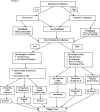Motivational Enhancement System for Adherence (MESA): pilot randomized trial of a brief computer-delivered prevention intervention for youth initiating antiretroviral treatment
- PMID: 23359664
- PMCID: PMC3701125
- DOI: 10.1093/jpepsy/jss132
Motivational Enhancement System for Adherence (MESA): pilot randomized trial of a brief computer-delivered prevention intervention for youth initiating antiretroviral treatment
Abstract
Objective: To pilot test a two-session computer-delivered motivational intervention to facilitate adherence among youth with HIV newly prescribed antiretroviral treatment (ART).
Methods: Youth (N = 76) newly prescribed ART were recruited from 8 sites, and were randomized to the intervention or an active nutrition and physical activity control. Primary outcomes were HIV-1 viral load at baseline, 3 months, and 6 months, and self-reported adherence at 3 and 6 months.
Results: Satisfaction ratings were high. Effect sizes suggested that the intervention group showed a greater drop than controls in viral load from baseline to 6 months (Cohen's d = 0.39 at 3 months; d = 0.19 at 6 months), and had greater percent undetectable by 6 months (d = 0.28). Effects sizes were medium to large for 7-day and weekend adherence.
Conclusions: A brief computer-delivered motivational intervention showed promise for youth starting ART and is ready to be tested in a full-scale clinical trial.
Keywords: HIV; adherence; adolescent; eHealth.
Figures
Similar articles
-
The initial feasibility of a computer-based motivational intervention for adherence for youth newly recommended to start antiretroviral treatment.AIDS Care. 2014 Jan;26(1):130-5. doi: 10.1080/09540121.2013.813624. Epub 2013 Jul 22. AIDS Care. 2014. PMID: 23869650 Free PMC article.
-
"+CLICK": pilot of a web-based training program to enhance ART adherence among HIV-positive youth.AIDS Care. 2012;24(3):310-8. doi: 10.1080/09540121.2011.608788. Epub 2011 Sep 8. AIDS Care. 2012. PMID: 21899488
-
A Multi-Site Study of Social Cognitive Factors Related to Adherence Among Youth Living With HIV in the New Era of Antiretroviral Medication.J Pediatr Psychol. 2019 Jan 1;44(1):98-109. doi: 10.1093/jpepsy/jsy076. J Pediatr Psychol. 2019. PMID: 30272202 Free PMC article.
-
A 2-arm, randomized, controlled trial of a motivational interviewing-based intervention to improve adherence to antiretroviral therapy (ART) among patients failing or initiating ART.J Acquir Immune Defic Syndr. 2006 May;42(1):42-51. doi: 10.1097/01.qai.0000219771.97303.0a. J Acquir Immune Defic Syndr. 2006. PMID: 16763491 Free PMC article. Clinical Trial.
-
Interventions to Improve Antiretroviral Therapy Adherence Among Adolescents and Youth in Low- and Middle-Income Countries: A Systematic Review 2015-2019.AIDS Behav. 2020 Oct;24(10):2797-2810. doi: 10.1007/s10461-020-02822-4. AIDS Behav. 2020. PMID: 32152815 Free PMC article.
Cited by
-
Technology-Delivered Adaptations of Motivational Interviewing for the Prevention and Management of Chronic Diseases: Scoping Review.J Med Internet Res. 2022 Aug 9;24(8):e35283. doi: 10.2196/35283. J Med Internet Res. 2022. PMID: 35943775 Free PMC article.
-
Service delivery interventions to improve adolescents' linkage, retention and adherence to antiretroviral therapy and HIV care.Trop Med Int Health. 2015 Aug;20(8):1015-32. doi: 10.1111/tmi.12517. Epub 2015 May 13. Trop Med Int Health. 2015. PMID: 25877007 Free PMC article.
-
Using Technology to Improve Adherence to HIV Medications in Transitional Age Youth: Research Reviewed, Methods Tried, Lessons Learned.J Gen Med (Dover). 2017;1(1):1002. Epub 2017 Sep 21. J Gen Med (Dover). 2017. PMID: 30345429 Free PMC article.
-
An Index of Multiple Psychosocial, Syndemic Conditions Is Associated with Antiretroviral Medication Adherence Among HIV-Positive Youth.AIDS Patient Care STDS. 2016 Apr;30(4):185-92. doi: 10.1089/apc.2015.0328. AIDS Patient Care STDS. 2016. PMID: 27028184 Free PMC article.
-
Feasibility of smartphone-enabled asynchronous video directly observed therapy to improve viral suppression outcomes among HIV unsuppressed children and adolescents in Kenya.BMC Infect Dis. 2025 Apr 30;25(1):636. doi: 10.1186/s12879-025-11036-9. BMC Infect Dis. 2025. PMID: 40307826 Free PMC article.
References
-
- Abrams D B, Orleans C T, Niaura R S, Goldstein M G, Prochaska J O, Velicer W. Integrating individual and public health perspectives for treatment of tobacco dependence under managed health care: A combined stepped-care and matching model. Annals of Behavioral Medicine. 1996;18:290–304. - PubMed
-
- Bangsberg D R. Perspectives on adherence and resistance to ART; Paper presented at the 18th Conference on Retroviruses and Opportunistic Infections; Boston, MA. 2011.
-
- Bartlett J G, Cheever L W, Johnson M P, Paauw D S. A guide to primary care of people with HIV/AIDS. 2004. Retrieved from www.hab.hrsa.gov/tools/primarycareguide.
-
- Berrien V M, Salazar J C, Reynolds E, Mckay K. Adherence to antiretroviral therapy in HIV-infected pediatric patients improves with home-based intensive nursing intervention. AIDS Patient Care and STDs. 2004;18:355–363. doi:10.1089/1087291041444078. - PubMed
Publication types
MeSH terms
Substances
Grants and funding
LinkOut - more resources
Full Text Sources
Other Literature Sources
Medical
Molecular Biology Databases



